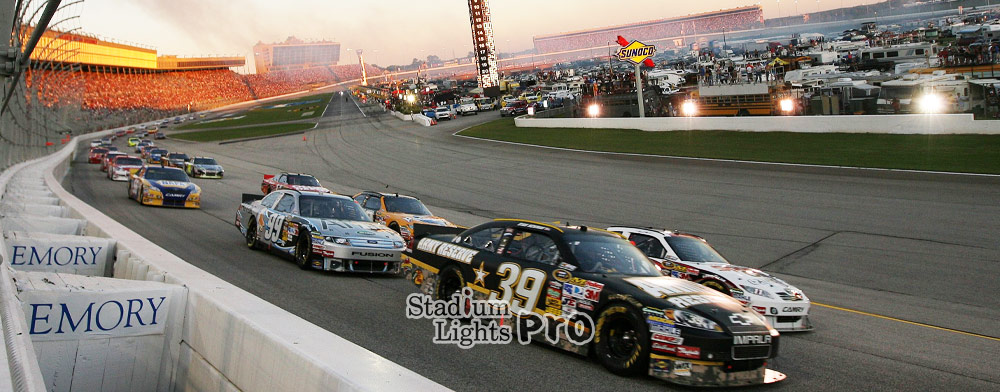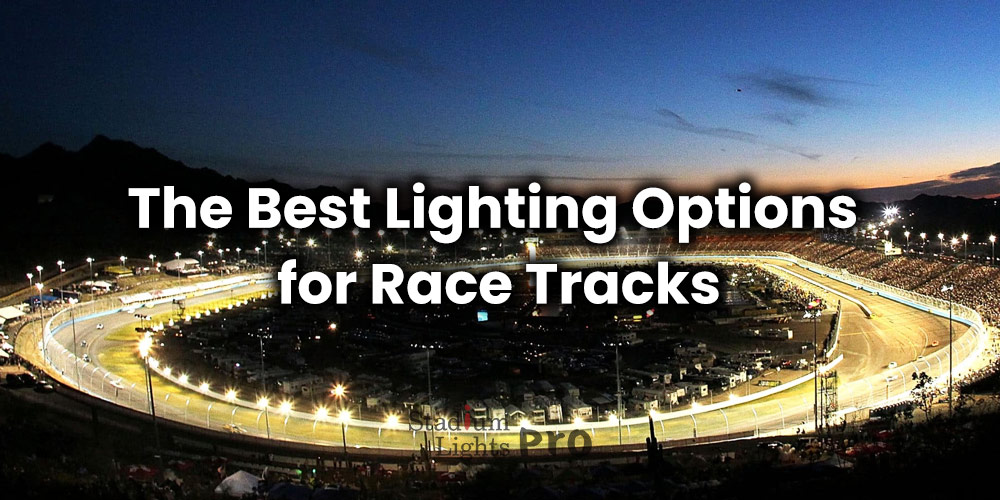Race tracks typically use a combination of different types of lights to ensure that the track is well-lit and safe for drivers and spectators.
Table of Contents
ToggleWhat lights are used to illuminate the race track?
Floodlights

Floodlights are large, high-intensity lights that are used to provide general lighting for a large area. They are often mounted on poles or towers and are designed to emit a wide beam of light that can cover a large area. Floodlights are commonly used in outdoor sports facilities, such as race tracks, to provide sufficient lighting for spectators and athletes.
Floodlights can be made with a variety of different light sources, including incandescent bulbs, halogen bulbs, and LED bulbs. Incandescent bulbs are the most traditional option, but they are not as energy-efficient as other options and tend to have a shorter lifespan. Halogen bulbs are more energy-efficient than incandescent bulbs, but they can produce a lot of heat and are not as long-lasting as LED bulbs. LED floodlights are the most energy-efficient and longest-lasting option, but they can be more expensive upfront.
Regardless of the light source, floodlights are typically used in areas where a large, bright light is needed, such as sports facilities, construction sites, and outdoor events. They are an essential component of any lighting system that is designed to provide adequate visibility and safety for athletes and spectators.
Track lights

Track lights are specialized lighting fixtures that are used to provide additional lighting for specific areas of a race track. They are typically smaller and more focused than floodlights, and are mounted on poles or towers along the track.
Track lights are often used to highlight specific areas of the track, such as corners or turns, to improve visibility for drivers. They can also be used to highlight pit lanes, garages, and other areas of the track that may be difficult to see in low light conditions.
Like floodlights, track lights can be made with a variety of different light sources, including incandescent bulbs, halogen bulbs, and LED bulbs. LED track lights are the most energy-efficient and longest-lasting option, but they can be more expensive upfront.
Start/finish lights
Start/finish lights are specialized lights that are used to signal the start and finish of a race on a race track. They are typically mounted at the start/finish line and may include a series of lights that change color to indicate the start or end of a race.
They are an essential safety feature on a race track, as they help to clearly communicate when the race is beginning or ending to drivers and officials. They may also be used to signal caution periods or other events during a race.
Start/finish lights can be made with a variety of different light sources, including incandescent bulbs, halogen bulbs, and LED bulbs. LED start/finish lights are the most energy-efficient and longest-lasting option, but they can be more expensive upfront.
In addition to being used for safety purposes, start/finish lights can also be used to add excitement and drama to a race. For example, some races may use flashing or strobe lights to create a more dramatic atmosphere.
Pit lane lights
Pit lane lights are lights that are used to mark the pit lane and indicate when drivers are allowed to enter or exit the pits during a race. They are typically mounted along the pit lane and may include a series of red and green lights that change color to indicate when the pit lane is open or closed.
They help to clearly communicate to drivers when they are allowed to enter or exit the pits. They also help to prevent accidents and collisions by clearly marking the boundaries of the pit lane.
Pit lane lights can be made with a variety of different light sources, including incandescent bulbs, halogen bulbs, and LED bulbs. LED pit lane lights are the most energy-efficient and longest-lasting option, but they can be more expensive upfront.
What is the best race track lighting option?
There are several advantages to using LED lights in a race track lighting system:
Energy efficiency
LED lights are much more energy efficient than other types of light sources, such as incandescent or halogen bulbs. This means that they use less electricity and can help reduce energy costs for the race track.
Long lifespan
LED race track lights have a much longer lifespan than other types of light sources, which means that they need to be replaced less frequently. This can save money on maintenance and replacement costs over time.
Durability
LEDs are more durable and resistant to damage than other types of light sources. This makes them ideal for use in a race track setting, where they may be exposed to vibration and other harsh conditions.
Brightness and color accuracy
LED racing lights are known for their high brightness and ability to produce a wide range of colors with great accuracy. This makes them ideal for creating dynamic lighting effects and enhancing the overall racing experience.
Environmental benefits
LED lights do not contain mercury or other harmful substances, making them more environmentally friendly than other types of light sources.
Conclusion
A variety of different lights are used on a race track to ensure that the track is well-lit and safe for drivers and spectators. Floodlights are large, high-intensity lights that are used to provide general lighting for the track. Track lights are smaller, more focused lights that are used to provide additional lighting for specific areas of the track. Start/finish lights are specialized lights that are used to signal the start and finish of a race. Pit lane lights are lights that are used to mark the pit lane and indicate when drivers are allowed to enter or exit the pits.

